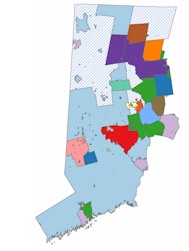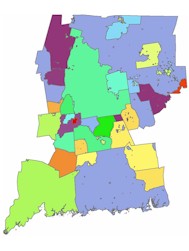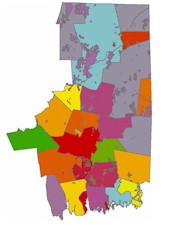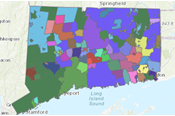 |
 |
 |
| Western WUCC | Central Corridor WUCC | Eastern WUCC |
| Water Utility Coordinating Committee Implementation Workgroup |
||
Coordinated Plan Statewide Summary Documents
Statewide Coordinated Water System Plan Summary (10 pg)
Connecticut’s Water Utility Coordinating Committee (WUCC) Process (2 pg flyer)
Western WUCC Executive Summary
Western WUCC Water Supply Assessment
Western WUCC Exclusive Service Areas
Western WUCC Integrated Report
Central WUCC Executive Summary
Central WUCC Water Supply Assessment
Central WUCC Exclusive Service Areas
Central WUCC Integrated Report
Eastern WUCC Executive Summary
Eastern WUCC Water Supply Assessment
Eastern WUCC Exclusive Service Areas
Eastern WUCC Integrated Report
Exclusive Service Areas
An Exclusive Service Area (ESA) is defined as an area where public water is supplied by one system. Numerous factors are considered in determining ESA designations in accordance with the regulations, including the following:
- Existing service areas;
- Land use plans, zoning regulations, and growth trends;
- Physical limitations to water service;
- Political boundaries;
- Water company rights as established by statute, special act, or administrative decision;
- System hydraulics, including potential elevations or pressure zones; and
- Ability of a water system to provide a pure and adequate supply of water now and into the future.
Establishment of boundaries for ESA holders is intended to ensure that safe and adequate drinking water is available to areas of the state where public water supply is needed. ESA designations are established based on the regulatory criteria noted above and are based upon the agreement by a utility or municipality to serve, as necessary, previously identified unserved areas in accordance with applicable state statutes and regulations.
Being an ESA holder is a commitment to ownership and service for newly constructed public water supply needs for community water systems (essentially, residential public water supply needs), and, in general, a right‐of‐first‐refusal for non‐community water systems (nonresidential) public water supply needs. An ESA designation therefore conveys both a right and a responsibility to provide public water service pursuant to applicable state law.
Exclusive Service Area Map (updated July 2018)
Changes to Exclusive Service Areas
Frequently Asked Questions - Exclusive Service Areas
Frequently Asked Questions - Exclusive Service Area Holders
General WUCC Information
- WUCC Webinar November 29, 2016 (MP4 Video)
- WUCC Webinar August 25, 2016 (MP4 Video)
- WUCC Timeline
- WUCC Factsheet
- Letter Regarding Exclusive Service Areas and Lands Under the Custody and Control of The Department of Energy and Environmental Protection dated February 1, 2017
- DPH Response to the February 1, 2017 DEEP Letter regarding ESAs
Historic WUCC Information


